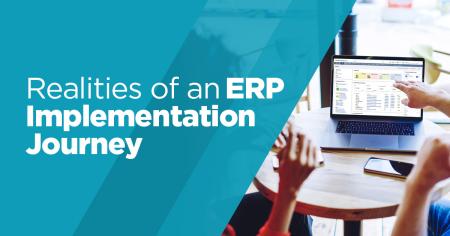One of the most difficult projects a company can undertake is the successful implementation of a new ERP.
In this recent article, Dominique Frechette (General Manager at GURUS Solutions) spoke with La Presse about the inconvenient truths surrounding an Enterprise Resource Planning (ERP) implementation.
Each business is unique in what they do and what they need. Why would your ERP be any different? Continue reading to learn more about the first step in any implementation plan.
What Are Common Misconceptions about an ERP Implementation?
This Is Not An IT Project
First, many organizations mistakenly view ERP implementation as solely an IT project. In reality, successful ERP projects require a close collaboration between IT and business stakeholders.
Request More Info About The Realities of an ERP Implementation Journey
The second misconception is that ERP systems are a one-size-fits-all solution.
While ERP systems do provide a robust foundation, their true power lies in their ability to be customized to meet the specific needs of an organization. Failing to recognize this can lead to issues down the road.
Challenges Implementing an ERP Solution
“Implementing an ERP system often impacts four or five departments. The people whose businesses will be disrupted must have a voice, from solution selection to final testing.”
Dominique Fréchette, Managing Director, GURUS Solutions
A major roadblock is the lack of involvement of key business stakeholders. Without a solid understanding of the organization’s operations, sales processes, and financial ins and outs, the ERP system may not meet the actual needs of the business.
Another challenge is that organizations often underestimate the workload and planning required for a successful ERP implementation. Senior teams, possessing in-depth business knowledge, need to be actively engaged.
Departments must be adequately staffed, with new hires taking over day-to-day tasks so that your implementation team can focus on the project at hand.
Finally, the question of whether to customize or adapt existing business processes to the ERP system introduces another layer of complexity. Striking the right balance between customization and embracing ERP best practices is a nuanced decision that requires careful consideration.
This phase is critical to the success of any ERP implementation project. Since it’s so important, you can imagine how difficult it will be to make a decision, especially if members of your team don’t share the same opinion.
Best ERP Implementation Practices
Starting proper change management early can help organizations avoid costly mistakes and ensure that they get the most out of their ERP investment. ERPs are software solutions that you will utilize, in theory, for many years. So if you’re planning on investing in the future, then a solid foundation is necessary.
Here are some tips to succeed:
Set clear business goals
Before you can start evaluating ERP vendors, you need to have a clear understanding of your business needs. This includes understanding your current business processes, the future state you want to achieve, and the specific functionality you need from an ERP system.
However, don’t confuse detailed requirements with business goals. Outlining detailed requirements too soon can cut the organization’s ability to embrace and process beneficial changes making system, or solution, selection almost impossible.
Take time choosing the right vendor
“Be wary if your vendor agrees to do everything you ask.”
Dominique Fréchette, General Manager at GURUS Solutions
Once organizations have a good idea of what they need from an ERP system, they can start looking at vendors. There are a few things to keep in mind when choosing a vendor, including their experience, track record, and customer references.
The ERP partner will often have a bigger impact on the success of the project than your selected solution.
Do your ERP homework
Organizations should carefully evaluate the ERP offerings of each shortlisted vendor. This includes evaluating the functionality, performance, and scalability of the ERP system.
Organizations should also consider the cost of the ERP system and the vendor's support offerings.
Again, prioritize business goals over any detailed requirements you might have. Those requirements are most likely a reflection of your current business processes and not your future processes.
Involve key stakeholders early
It's crucial to involve key stakeholders early. This includes business users, IT staff, and management. By involving key stakeholders, organizations can ensure that the ERP system meets the needs of everyone involved.
Set realistic expectations
Setting realistic expectations can help organizations and decision-makers avoid disappointment. Although it would be optimal to know exactly what you want before you start your first meeting, realistically your vendor might suggest solutions that you haven’t considered before.
If you’ve chosen the right vendor, those suggestions will often improve your experience and save you money.
Be prepared to make changes
Early on in the process, nothing is set in stone. Companies should be willing to alter their business requirements and ERP choices as they learn more about their possibilities. Companies can ensure they get the best possible ERP system for their needs by being prepared to make changes.
Embarking on an ERP implementation journey is a strategic decision that can significantly enhance operational efficiency and competitiveness. By understanding the common pitfalls and embracing best practices, organizations can navigate this complex process more effectively.
GURUS Solutions is committed to guiding businesses through their ERP implementation journey, ensuring a successful transformation tailored to their unique needs.
Learn More About The Realities of an ERP Implementation Journey

